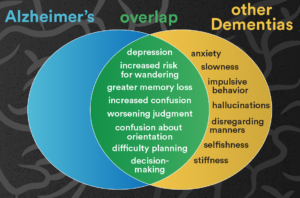People with this disease:
- In 2014, as many as 5 million Americans were living with Alzheimer’s disease.
- The symptoms of the disease can first appear after age 60 and the risk increases with age.
- Younger people may get Alzheimer’s disease, but it is less common.
- The number of people living with the disease doubles every 5 years beyond age 65.
- This number is projected to nearly triple to 14 million people by 2060.
Scientists do not yet fully understand what causes Alzheimer’s disease. There probably is not one single cause, but several factors that affect each person differently.
- Age is the best known risk factor for Alzheimer’s disease.
- Family history—researchers believe that genetics may play a role in developing Alzheimer’s disease.
- Changes in the brain can begin years before the first symptoms appear.
- Researchers are studying whether education, diet, and environment play a role in developing Alzheimer’s disease.
- Scientists are finding more evidence that some of the risk factors for heart disease and stroke, such as high blood pressure and high cholesterol may also increase the risk of Alzheimer’s disease.
- There is growing evidence that physical, mental, and social activities may reduce the risk of Alzheimer’s disease.
Alzheimer’s disease is
- One of the top 10 leading causes of death in the United States.
- The 6th leading cause of death among US adults.
- The 5th leading cause of death among adults aged 65 years or older.
In 2014, an estimated 5 million Americans aged 65 years or older had Alzheimer’s disease. This number is projected to nearly triple to 14 million people by 2060.
In 2010, the costs of treating Alzheimer’s disease were projected to fall between $159 and $215 billion.4 By 2040, these costs are projected to jump to between $379 and more than $500 billion annually.4
Death rates for Alzheimer’s disease are increasing, unlike heart disease and cancer death rates that are on the decline.5 Dementia, including Alzheimer’s disease, has been shown to be under-reported in death certificates and therefore the proportion of older people who die from Alzheimer’s may be considerably higher.
Various disorders and factors contribute to the development of dementia. Neuro-degenerative disorders result in a progressive and irreversible loss of neurons and brain functioning. Currently, there are no cures for these types of disorders. They include:
Other types of progressive brain disease include:
- Vascular contributions to cognitive impairment and dementia
- Mixed dementia, a combination of two or more types of dementia
In addition, certain medical conditions can cause serious memory problems that resemble dementia. These problems should go away once the conditions are treated. These conditions include:
- Side effects of certain medicines
- Emotional problems, such as stress, anxiety, or depression
- Certain vitamin deficiencies
- Drinking too much alcohol
- Blood clots, tumors, or infections in the brain
- Delirium
- Head injury, such as a concussion from a fall or accident
- Thyroid, kidney, or liver problems
Doctors have identified many other conditions that can cause dementia or dementia-like symptoms. These conditions include:
- Argyrophilic grain disease, a common, late-onset degenerative disease
- Creutzfeldt-Jakob disease, a rare brain disorder
- Huntington’s disease, an inherited, progressive brain disease
- Chronic traumatic encephalopathy (CTE), caused by repeated traumatic brain injury
- HIV-associated dementia (HAD)
The overlap in symptoms of various dementias can make it hard to get an accurate diagnosis. But a proper diagnosis is important to get the right treatment. Seek help from a neurologist—a doctor who specializes in disorders of the brain and nervous system—or other medical specialist who knows about dementia.
